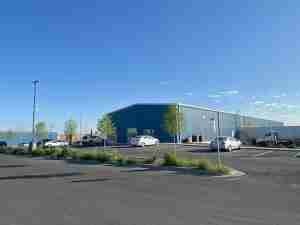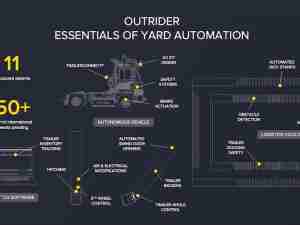The Uberization of trucking: Why it might succeed
By: Peter Buxbaum | Sep 26 2016 at 08:33 AM | Intermodal
Last month Uber acquired a tech startup, Otto, that specializes in trucking transportation. Instantly the Uberization of trucking went from hypothetical to a working proposition. The question now is will it succeed?
It’s a question that has been on the lips of transportation types for the last few years. Could Uber work for trucking?
The question is no longer moot. Last month Uber, the enormously successful ride-sharing app, announced it was acquiring Otto, a 90-person technology startup whose mission is to rethink transportation, starting with self-driving trucks.
What we’re talking about, really, is the uberization of transportation, ta phenomenon, which ironically, may not need to involve Uber itself. There are already a number of companies out there that purport to offer online services and mobile apps to match trucks with loads. Whether they have been at all successful is another matter.
The whole point of a trucking Uber would be to help short-haul truckers and local couriers. Long-haul lanes have lower empty-mile percentages.
Digital Freight Management?
By the way, the research firm Armstrong & Associates doesn’t think we should be calling this Uber for Trucking. They suggest Digital Freight Management (See sidebar on page 19).
Trucking currently runs on fairly manual processes, with people calling each other on the phone and sending emails and paperwork to arrange shipments and confirming deliveries. It’s a system that is ripe for automation.
What these Uber-like apps do is to match companies that need goods moved with drivers able to move them. Like Uber, it solves the excess capacity problem that many Silicon Valley app developers attempt to address. Truckers, like car drivers, often travel from Point A to Point B with room to spare. The apps let the drivers know if anyone is willing to pay them to occupy the free space.
The shipper logs into the apps, enters details about what the shipment is, its destination, and when it needs to get there. Qualified drivers see the job pop up on their app, and the first to click “book it” gets the work.
Crowded Field
There are 27 technology startups that match truckers with loads, according to Armstrong & Associates, and they have raised more than $180 million in venture backing in the last five years. Some of the biggest include Otto, Cargomatic, OMVS, ShipX, Convoy, Transfix, Cargo Chief, and Trucker Path. It’s clear that not all of them are success stories.
The early scuttlebutt was that Uber and its cohorts could potentially pose a threat to aspects of the 3PL industry. These companies could eventually become 3PL businesses, by providing last-mile delivery services, and becoming a small LTL carrier and taking business away from small-volume couriers. Some of these app providers have actually moved to one extent or another into the realm of transporting physical goods.
Uber’s plans for Otto appear to go way beyond matching loads with drivers. “More and more the world of atoms is interacting with bits,” said Travis Kalanick, Uber’s CEO, explaining the Otto deal. “In order to provide digital services in the physical world, we must build sophisticated logistics, artificial intelligence, and robotics systems that serve and elevate humanity.”
The American Trucking Associations recently published a forecast, which predicts the industry will enjoy a 29% increase in freight volumes by 2026. The short-haul LTL business has revenues of about $77-billion-a-year, on journeys of 200 miles or less.
With the nation’s trucking industry in the midst of a growth spurt, On the Move Systems (OMVS) says its upcoming on-demand platform, self-described as a kind of Uber for trucking, offers freight haulers what the company’s CEO claims is “a cutting-edge technology based solution to keep the good times rolling.”
The outlook for freight transportation and the perennial driver shortage in the U.S. trucking industry “indicate a real opportunity for a technology solutions company like ours,” said Robert Wilson CEO of OMVS. “The predicted freight volume increase should drive demand for our shared economy platform, as firms will want to optimize these additional loads and routes.” Trucking companies will need drivers to haul these additional loads and the OMVS app can help connect companies with local independent drivers who want to contract with carriers, Wilson added. OMVS was recently reported to be looking into acquiring an LTL company.
Recently launched to the commercial market, ShipX also provides an online less-than-truckload freight exchange to connect shippers with freight carriers. ShipX aims its online exchange at small businesses that have little time to navigate the LTL industry. A digital interface allows shippers to compare live quotes from dozens of carriers and enjoy volume discounts, regardless of the shipment size. This is supposed to level the playing field for smaller shippers that rely on LTL for their business needs, according to ShipX founder and CEO Augie Grasis.
“We were new to LTL shipping,” said Grasis. “We had a new set of eyes looking at the industry. It didn’t take long to realize that we could provide real value for LTL shippers nationwide by creating this online LTL marketplace but would need to disrupt the traditional way of doing things.”
ShipX is one of the few online trucking exchanges that can point to shipper success stories. “I thought I was getting a great volume rate from my local carrier,” said Mike Taranto, president of Solar Shade USA. “ShipX found me multiple carriers with lower prices and we have saved 80% over our contracted LTL rates.”
ShipX wants to make LTL shipping a convenient and efficient freight option for less-frequent shippers and small businesses,” said Grasis. “Adding technology to the booking process,” he added, “creates a transparent pricing model, saves time for users, and revolutionizes the way shippers buy LTL freight.”
The Cargomatic story contains perhaps the biggest object lesson for the industry. After serving Southern California since 2014, the company opened New York and San Francisco operations the following year.
But after raising $20 million in venture funding, Cargomatic may be heading for the exits. Recent reports indicate that the company is running out of money, that many of its top executives have fled the company, and that it has laid off half of its staff. In a bizarre twist, one report revealed that Cargomatic had secretly moved away from its original technology centric mission and was operating as a traditional truck brokerage pursuing corporate accounts and using third-party software.
As it turned out, truckers were slow to adopt Cargomatic’s core product. The company also suffered from ignorance of the LTL industry where density is required in order to succeed. The company’s brokerage business apparently has sufficient revenue to make it attractive to a buyer, if the company doesn’t fold before a takeover can be arranged.
Could Uber succeed where Cargomatic failed? It’s possible. Reports indicate that Uber raised $5.5 billion from investors just in the few months. That might just give the company the cash to develop its trucking app just right and time to test it, tweak it, and accept losses until it achieves sufficient critical mass to make it profitable.







